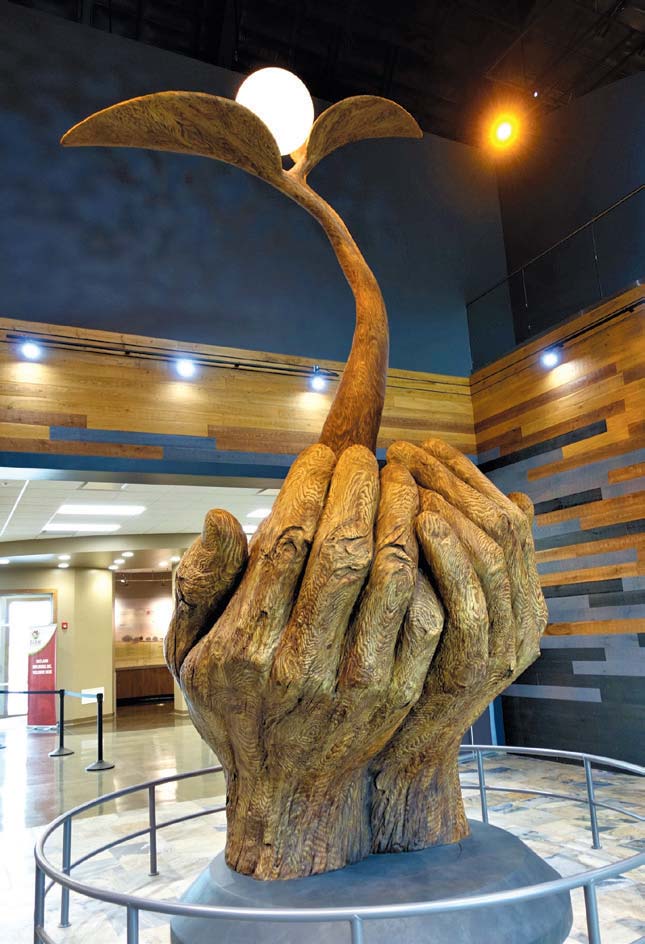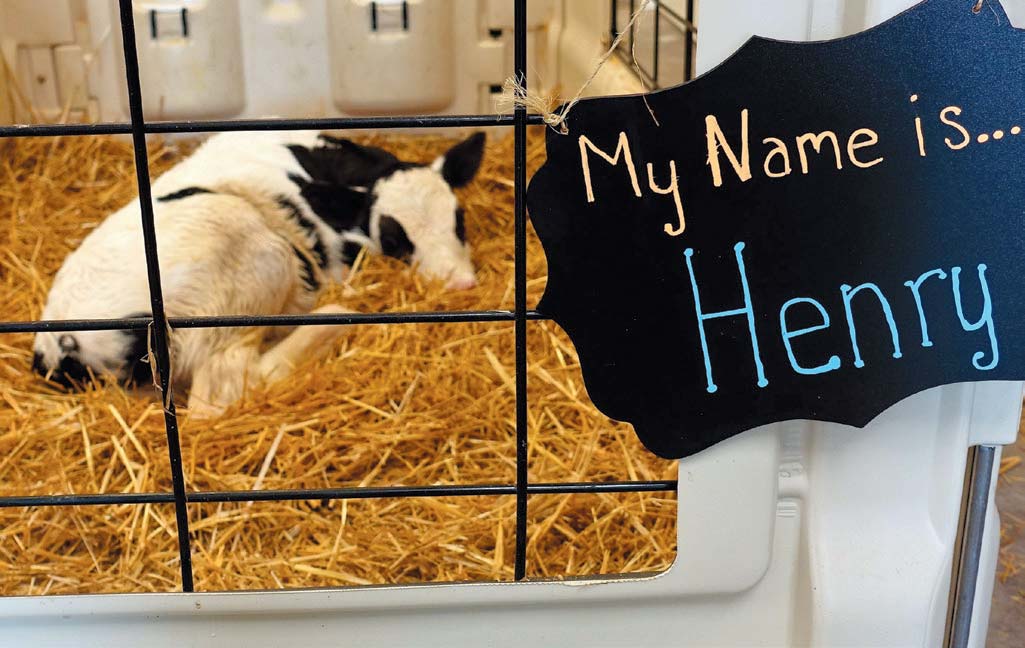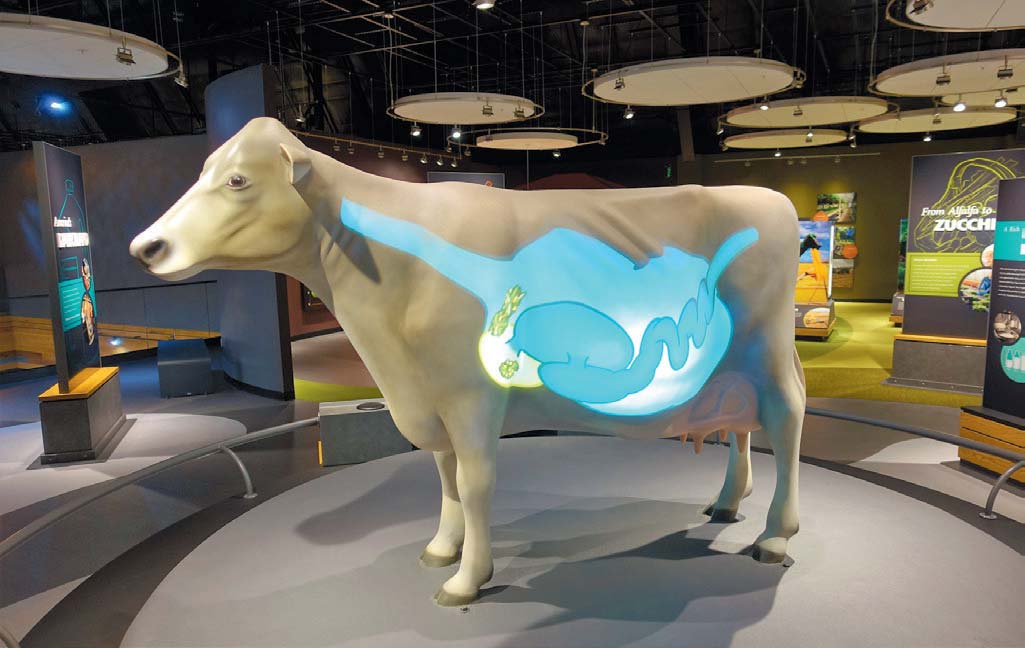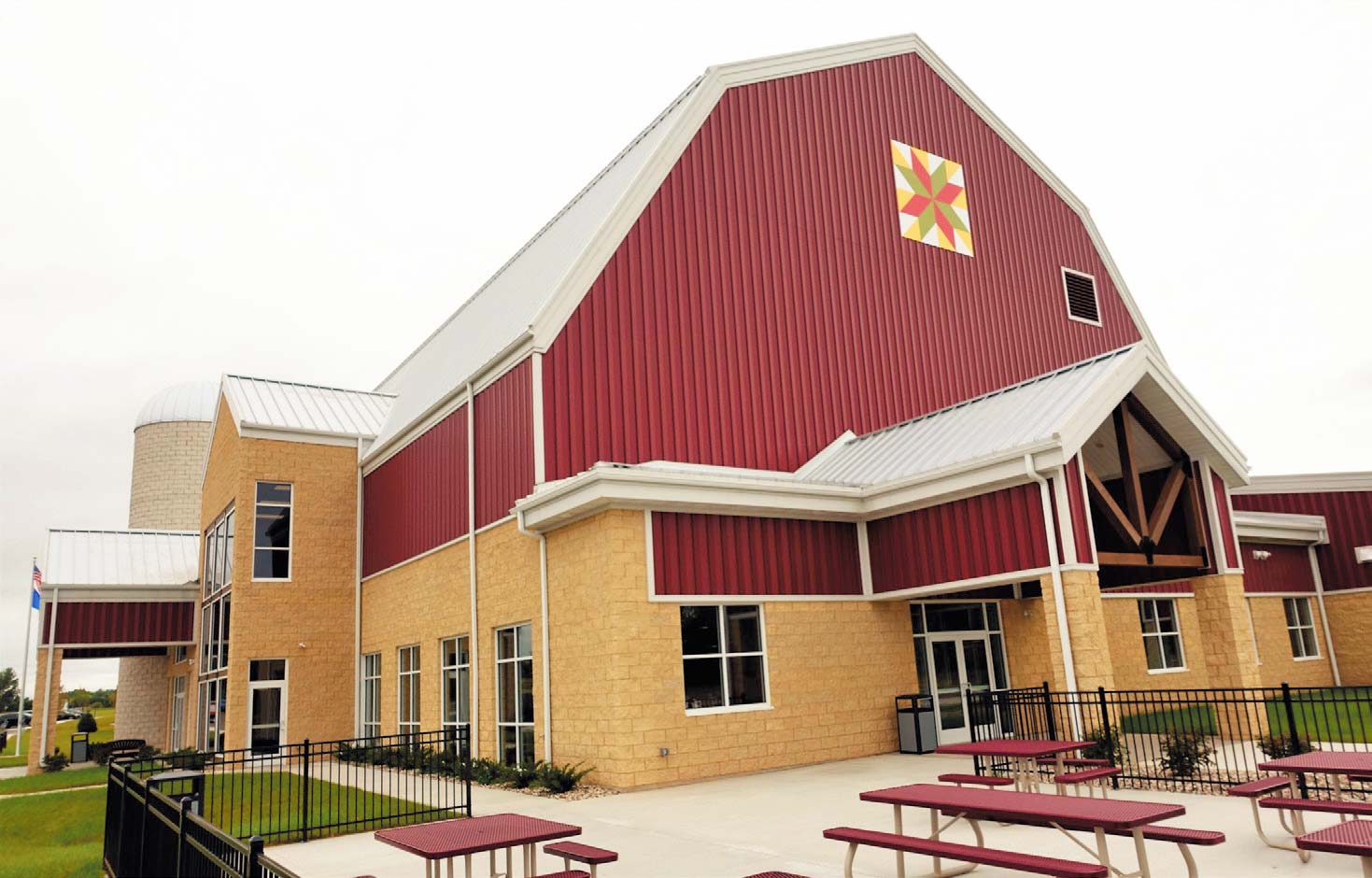Wisconsin Farming on Display
NEW AGRICULTURAL CENTER OFFERS INTERACTIVE DISPLAYS TO LIVE CALF BIRTHING
 Once inside the barn, visitors are greeted by a statue of a farmer’s hands created by Split Rock Studio.
Once inside the barn, visitors are greeted by a statue of a farmer’s hands created by Split Rock Studio.
NEW AGRICULTURE EDUCATION CENTER IN MANITOWOC FIRST OF ITS KIND IN WISCONSIN
The agriculture industry is advancing so rapidly that farmers don’t always have time to tell consumers their story ... well, because they are busy farming.
In an age when consumers’ curiosity about where their food comes from is piqued, it’s a missed opportunity if consumers and farmers are not on the same page.
Enter the new Farm Wisconsin Discovery Center in Manitowoc to tell the Wisconsin farmers’ story.
“Our goal is to take visitors beyond the barn and educate how Wisconsin agricultural producers make food, fiber, and fuel – safely, humanely and sustainably,” is the Farm Wisconsin Discovery Center’s mission.
“Farm Wisconsin answers the question, where does my food come from and showcases Wisconsin family farms and other agricultural producers and processes,” says Angel Johanek, director of marketing and development.
In the short time the Farm Wisconsin Discovery Center in Manitowoc has been open, it has drawn visitors from across the state, nation and even Ireland, Japan, Netherlands, and Brazil, among other countries. And no matter whether those visitors grew up in agriculture or have never stepped toe on a farm, they walk away more knowledgeable about the significant role modern Wisconsin agriculture plays in daily life.
Spend a few hours, or a whole day, and this new agriculture education center will have you testing your strength at lifting 40-pound blocks of cheese and searching for the Wisconsin agricultural connection in the production of false eyelashes. You might spend time harvesting corn behind the wheel of a John Deere combine simulator. And, if you are lucky in your timing and willing to linger in the birthing barn auditorium, you may witness the miracle of a cow giving birth and watch that newborn calf draw its first breath of life.
In addition to the 10,000-square-foot exhibition space and the birthing barn, the Farm Wisconsin Discovery Center boasts the onsite Wisconsin Café featuring Wisconsin-sourced ingredients (see related story), a 300-person conference center, gift shop and tours of a nearby dairy farm. Also included on the Farm Wisconsin property is lab and classroom space used by students of Lakeshore Technical College’s dairy program.
Farm Wisconsin has been a project in the making for eight years, with the vision initially driven by Norval Dvorak.
Dvorak not only worked a family farm in Manitowoc County but also taught high school agriculture classes, helped World War II veterans start farming, and assisted many foreign countries in development of their agriculture systems, including Czechoslovakia as they converted from a communist to private agriculture system.
 A bull calf rests in a viewing area shortly after having his birth witnessed by an auditorium of visitors in the birthing barn of the Wisconsin Farm Discovery Center.
A bull calf rests in a viewing area shortly after having his birth witnessed by an auditorium of visitors in the birthing barn of the Wisconsin Farm Discovery Center.
A dedicated group of volunteers, and later a small staff, would go on to spend countless hours of research, exploration, fundraising and planning to make the Farm Wisconsin Discovery Center a reality, and the first dedicated agriculture education center of its kind in Wisconsin.
Melissa Bender, director of educational programming for Farm Wisconsin, notes that when fundraising began after the initial feasibility study, $425,000 was raised in the first two months from local farmers and agriculture businesses.
“They were putting their money out there for this vision and we didn’t even have the land yet,” Bender said.
In 2015, a formal capital campaign was launched with a goal of $13 million. Land O’Lakes Dairy quickly stepped up to the plate with a $1 million donation. That was followed by a $5 million matching fund grant from the State of Wisconsin, only to have the Center deliver on their matching obligation within two short years, thanks to a long string of farms and businesses proudly wanting to be a part of this nonprofit endeavor. When it came time for the Farm Wisconsin staff and volunteers to determine the range of information visitors should be educated about, the idea cup overflowed.
Bender indicates the group had so much information they wanted to convey that it might have been overwhelming to visitors. A Minnesota- based exhibit company helped them boil the information down, make it concise and center it around main themes.
For an exhibit company that was not agriculturally oriented, a remarkable job was done building depth into enticing displays. Most displays contain both elements of hand-on interaction and static information so that kids can play while adults might be reading. Still, it would be the rare adult who did not also get drawn into the joy of the hands-on play while learning.
Getting accurate information about the agriculture industry was a task itself, says Bender.
“To get the information right, you can’t go to Google,” she said. “You have to go to the experts.”
She said multiple commodity organizations, like the Wisconsin Cranberry Growers and Wisconsin Corn Growers, were extremely helpful in providing videos, photos and educational information about their sectors of the agriculture industry.
Brimming with bright photography and dynamic video screens throughout the Center, Farm Wisconsin is proud to point out visitors are truly getting a glimpse of Wisconsin, and not agriculture in other states.
“Ninety-eight percent of the photos in the displays were taken in Wisconsin,” says Johanek, “and some of those were really hard to find.”
The exhibits center around six main themes: Wisconsin’s dairy industry, the diversity in Wisconsin agricultural products, how food gets from field to your fork, finding common ground between agriculture and environmental interests, the advancements in agriculture technology, and the people in agriculture.
 The Metabolic Marvels exhibit explains the path a cow’s food takes through the four compartments of a cow’s stomach: the reticulum, rumen, omasum and abomasum.
The Metabolic Marvels exhibit explains the path a cow’s food takes through the four compartments of a cow’s stomach: the reticulum, rumen, omasum and abomasum.
“To get the information right, you can’t go to Google,” she said. “You have to go to the experts.” — Melissa Bender
Given the stimulating nature of the exhibits and the general excitement and energy of visitors, it is hard to imagine that you’d find a serene enough environment where a cow would be able to settle down to give birth – let alone give birth before an auditorium of onlookers. But Farm Wisconsin has accomplished just that.
One only needs to walk down a quiet vestibule past the exhibit area to transition them to watching the miracle of birth. On any given day, one can find a cow at some point mid-labor, on a glassed-in stage in full view of an auditorium filled with awestruck visitors. Farm Wisconsin is outfitted to handle 1-5 live births per day.
The cast of cows put on stage is selected by Birthing Barn Manager Katie Wade each morning when she visits Farm Wisconsin’s nearby partner, Grotegut Dairy Farm, located just 2½ miles away.
Wade walks through the pens of cows nearing birth, scouting for those with signs that delivery is close. She also looks for signs that the cow has a temperament to handle her big day while also being on a public stage. Wade loads the cows onto a trailer, saying the process goes best when you let the cows make choices for themselves.
“Once we get to the Birthing Barn, we just take things slow,” Wade says. “I just open the back of the trailer and let them decide when they are ready to get off. Then I let them pick their own pen. There’s no rush.”
Wade studied animal science at Colorado State under Dr. Temple Grandin, a renowned consultant on animal behavior to the livestock industry as well as a spokesperson in the autism community.
Wade indicates the cows fully realize they have an audience.
While most cows handle the publicity quite well, Wade said she watches for signs the that being on view is making the cow antsy, or the reverse ... the cow is distracted from her labor because she is people-watching. In those cases, cow and calf safety are the No. 1 priority, and she may alter visitor traffic, or move the cow to the back of the barn to birth privately. With her office window looking directly into the birthing pens, Wade realizes she’s on display, too.
“I like the transparency of the whole environment,” she said. “People just want to know what’s going on,” she says, noting that she frequently wears a microphone so she can narrate the birthing event over the loudspeakers or explain to the audience what’s happening if she needs to enter the birthing pen. There are rules for visitors who enter the Birthing Barn: No running, cellphones off, and voices at no more than a whisper. Crowd management is not usually an issue, Johanek says, “Most people really respect that there is an animal giving birth.”
For those visitors wanting to see even more live action, Farm Wisconsin offers four daily 35-minute tours by bus to nearby Grotegut Dairy Farm. In a turn of tables, on the tours it is the visitors behind the glass windows and the cows
are known to watch with eagerness when the tour bus drives through the barn. Farm Wisconsin Discovery Center is positioning itself for the future by developing ongoing educational programing and events. Already there are weekly story times and the conference center is being booked for corporate events and even weddings.
The Farm Wisconsin Discovery Center is located at 7001 Gass Lake Road in Manitowoc, just off Interstate 43, Exit 144. It is open 9 a.m.-5 p.m. every day except holidays. For more information, go to farmwisconsin.org or call 920-726-6000.





